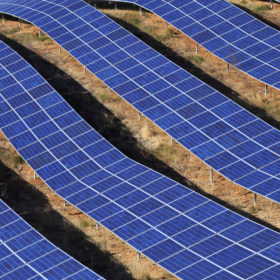
New research from Cornwall Insight shows that grid-scale solar farms are paying 10% to 20% of the cost of providing frequency ancillary services to Australia's National Electricity Market, despite currently generating around 3% of energy in the system.
Curtailment, connection delays, marginal loss factors, an inadequate electricity transmission system, the ongoing Federal energy-policy vacuum — the list of considerations and potential detractors from the solar developer’s bottom line is ever expanding. New calculations by energy analysts Cornwall Insight now find that solar farms are disproportionately shouldering the growing cost of providing frequency control ancillary services (FCAS) in the National Electricity Market (NEM).
Cornwall Insight reports that solar farms pay between 10% and 20% of total regulation FCAS costs in any given month, when at this stage they produce only around 3% of energy generated in the NEM. In comparison, wind farms provided some 9% of energy in the NEM during the financial year 2019-20, and their cumulative FCAS causer pays tally came to around 10% of total regulation costs.
The “causer pays” factor refers to how much any generator deviates from their linear ramp rate to meet their next energy dispatch target for each dispatch period.
“A new operational consideration for renewables is the liability that high regulation FCAS prices pose to the profitability of current and future renewable energy projects,” says Ben Cerini, principal consultant at Cornwall Insight Australia.
The company’s research shows that FCAS causer pays costs for grid-scale solar generators are conservatively around AU$2,368 (US$1,700) per megawatt each year, or around $1.55/MWh. However, this varies across NEM regions, with Queensland solar farms having higher causer pays factors in fiscal 2020 than those borne in other states.

“Since 2018, regulation FCAS costs have fluctuated between $10 million to $40 million a quarter,” said Cerini.
Separation anxiety
Deploying FCAS allows the Australian Energy Market Operator (AEMO) to manage deviations in generation or load. The main contributors to the very high FCAS costs of the first quarter this year were three unexpected “separation” events. Multiple transmission lines in southern NSW tripped as a result of the bushfires, separating northern from southern regions of the NEM on Jan. 4. Then, the most costly separation occurred when South Australia and Victoria were islanded for 18 days, following a storm that crippled transmission lines on Jan.31. Finally, the separation of South Australia and western Victoria’s Mortlake Power Station from the NEM on March 2.
When the NEM operates as a connected system FCAS can be sourced from throughout the grid, allowing AEMO to call on the cheapest offers from providers such as generators, batteries and loads. During separation events, FCAS must be locally sourced, and in the case of the 18-day separation of South Australia and Victoria, it was met by increased supply from gas-fired generation.
As a consequence, NEM system costs in the first quarter were $310 million, of which a record $277 million was chalked up to FCAS needed to maintain grid security in these extraordinary circumstances.
The return to a more typical system costs tally of $63 million in Q2, of which FCAS made up $45 million, was “primarily due to the lack of occurrence of major power system separation events”, said AEMO in its Q2 2020 Quarterly Energy Dynamics report.
Large-scale solar
At the same time, the second quarter saw the average regional wholesale electricity spot prices reach their lowest levels since 2015; and 48-68% lower than they were in the second quarter of 2019. AEMO listed the contributing factors to reduced wholesale price offers as: “lower gas and coal prices, easing of coal constraints at Mount Piper, increased rainfall (and hydro output), and new renewable supply”.
Grid-scale variable renewable energy output (wind and solar) increased by 454 MW in the second quarter, accounting for 13% of the supply mix, up from 10% in the second quarter of 2019.

Lowest-cost renewable energy will only increase its contribution to reducing wholesale energy prices; and a more distributed and strengthened web of interconnected transmission, along with revised rules governing battery connection in the NEM, hold the key to ensuring access to competitively priced FCAS as needed.
In the meantime, Cerini says developers and investors are closely monitoring any increased risks to project costs. “As wholesale prices have fallen, potential power purchase tenures have shortened, and loss factors have fluctuated,” he explains.
Cornwall Insight has flagged its intention to provide FCAS price forecasting starting in September 2020, although the kinds of events which caused FCAS to spike in the first quarter are hard to anticipate.
“FCAS liabilities are now firmly on the due diligence agenda,” Cerini says.
Lắp đặt điện mặt trời Khải Minh Tech
https://ift.tt/2X7bF6x
0906633505
info.khaiminhtech@gmail.com
80/39 Trần Quang Diệu, Phường 14, Quận 3
Lắp đặt điện mặt trời Khải Minh Tech
https://ift.tt/2ZH4TRU
Không có nhận xét nào:
Đăng nhận xét